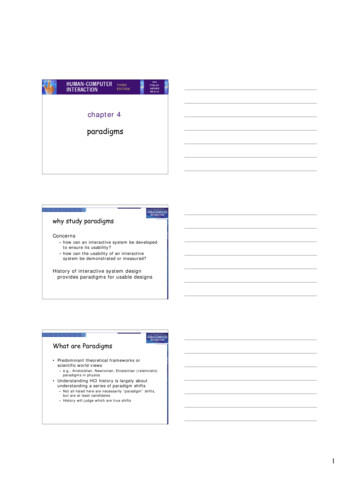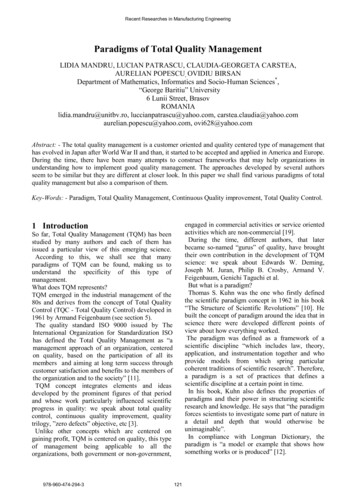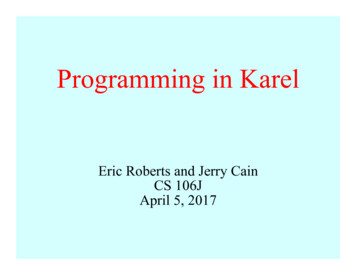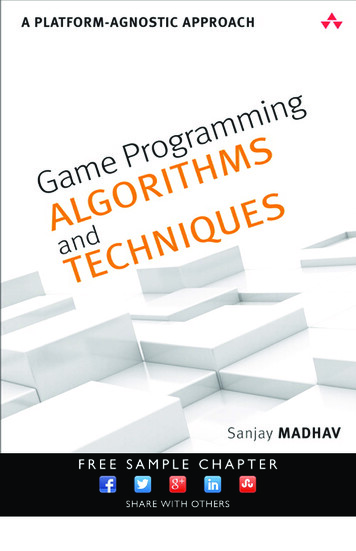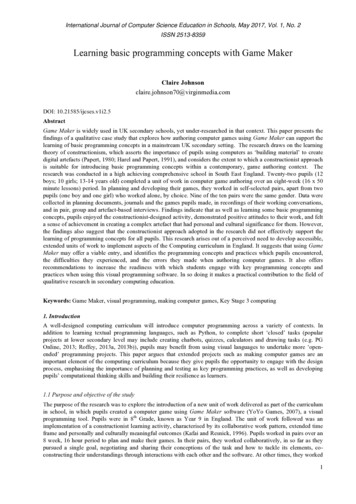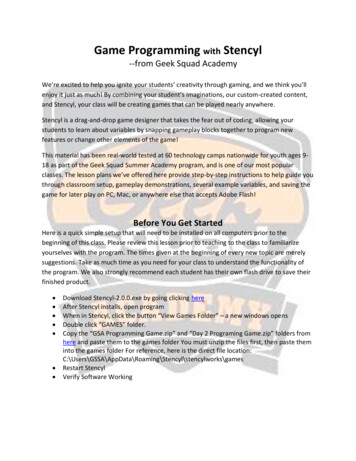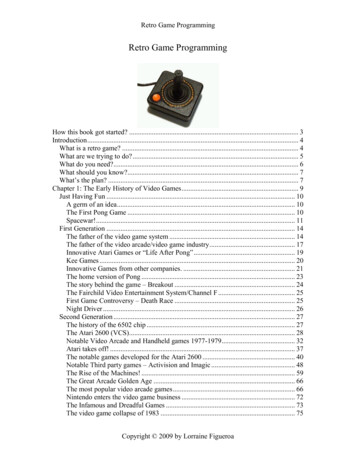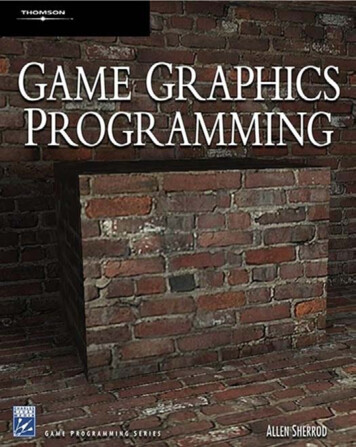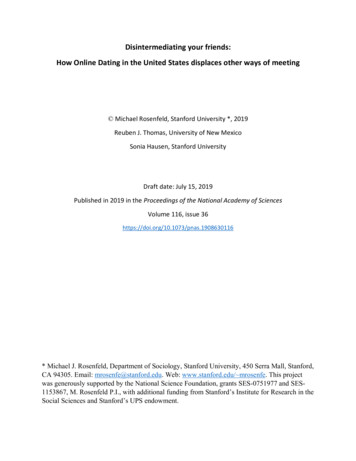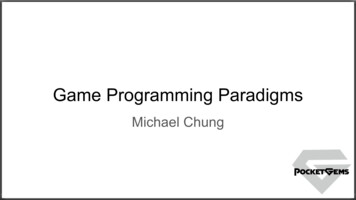
Transcription
Game Programming ParadigmsMichael Chung
CS248, 10 years ago.
Goals
Goals1.High level tips for your project’s game architecture
Goals1.High level tips for your project’s game architecture2.Some perspective on where Unity falls short
Outline1.2.3.4.Game loops and simulationsHandling interactionsControlsEntity component system
Outline1.2.3.4.Game loops and simulationsHandling interactionsControlsEntity component system
Game LoopGame loops handle all game simulation logic:-Add / remove entitiesHandle player inputsUpdate game logic systemsHandle movement, physics and collisionsGenerate state for the view layer
Game LoopGame loops decouple your simulation timeline from:-User inputProcessor speed
Unity’s Game .html
Unity’s Game LoopGame logic in Update()?Worry less about view interpolationCouples simulation frequency withrendering loop
Unity’s Game LoopGame logic in FixedUpdate()?In sync with physics loopEasier to reason with a discretequantized timelineYour views will be jittery if youdon’t interpolate correctly
Unity’s Game LoopWhat about ordering of behavior within game loop?
Unity’s Game Loop
Unity’s Game Loop
Unity’s Game Loop
Unity’s Game LoopYou can order component priorities with a customized script execution order.But that means you are defining one ordering for:-InitializationUpdatesTeardownNot always convenient:-Hard to make sense of the merged orderingMaybe you want different orderings
Unity’s Game LoopYou may also have cyclical dependencies between components during yourinitialization steps.You could split components to solve this problem, but that may require you toupdate a lot of prefabs, and may increase coupling between components.You could split initialization code between Awake() and Start(), but that’s reallybad.A good way to solve this problem is to separate your behaviors from your state,and not use Unity’s callbacks for most of your components.
SimulationObject that encapsulates loop and state
SimulationIn Unity, there is one simulation running at all times.You have very little control over it:-You can’t fast forward / rewind / replayYou can’t instantiate multiple simulationsYou can’t differentiate initialization order from update orderYou can’t define multiple initialization / update behaviors on the samecomponent
SimulationYou can solve all of these problems by creating your own simulation class.
Multiple Simulations
Multiple Simulations
Outline1.2.3.4.Game loops and simulationsHandling interactionsControlsEntity component system
Interaction Resolution
Interaction Resolution
Interaction Resolution
Interaction ResolutionSlap!
Interaction Resolution
Interaction Resolution
Interaction Resolution
Interaction Resolution
Interaction Resolution
Interaction Resolution
Interaction Resolution
Interaction Resolution
Interaction Resolution
Interaction ResolutionDo we care? Maybe.-Turn based simulationsCompetitive gamesConsistently biased small advantages can add up
Double buffering
Double buffering
Double bufferingAfter swapping, instead of a buffer clear on the active buffer, we do a buffer copy.The buffer copy can be unnecessarily expensive:-Game states can be largeUsually only a small portion of the game state changes each tickPotentially use this concept on pieces of state, or avoid it completely.
Message queues
Message queues
Message queues
Outline1.2.3.4.Game loops and simulationsHandling interactionsControlsEntity component system
Controls
Controls - “Command” Pattern
Controls - “Command” Pattern
Controls - “Command” Pattern
Controls - Input Handlers
Controls - Input Handlers
Controls - Input Handlers
Controls - Input with durationSome controls are kept activated.For example, holding a button down for movement.
Controls - Input with durationCould try this:-Activation command on key downDeactivation command on key up
Controls - Input with durationCould try this:-Activation command on key downDeactivation command on key upCouple problems:-Callbacks may be missedConflicting controls could be a problem
Controls - Input with durationYou could poll the input state, and keep track of input handler activation.
Controls - Input with duration
Controls - Input with duration
Controls - Input with duration
Controls - Input with duration
Controls - Input with durationLet’s update our input handlers for “Jump” and “Fire”.
Controls - Input with durationNow add input handlers for moving left and right.
Controls - Simultaneous inputsWhat about conflicting controls?What happens when you press multiple buttons at the same time?
Controls - Simultaneous inputs
Controls - Simultaneous inputs
Controls - Simultaneous inputs
Controls - Simultaneous inputs
Controls - Simultaneous inputs
Controls - Simultaneous inputs
Controls - Simultaneous inputsSometimes you want to handle only one input at a time out of a set of inputs.
Controls - Simultaneous inputsSometimes you want to handle only one input at a time out of a set of inputs.Priority of input may be based on various factors:-How recent is the input?What are the gameplay effects of the input?
Controls - Simultaneous inputsSometimes you want to handle only one input at a time out of a set of inputs.Priority of input may be based on various factors:-How recent is the input?What are the gameplay effects of the input?Are these relationships gameplay rules, or input rules?
Controls - Simultaneous inputsYou can use state machines, not only for animation, but also for gameplay logic.In our movement system, you are either idle, moving left, or moving right.
Controls - Simultaneous inputs
Controls - Simultaneous inputsLet’s examine our movement code again.Releasing one direction button could end movement in the opposite direction.We don’t want that.
Controls - Simultaneous inputsInstead of requesting velocity modifications, we request state transitions.
Outline1.2.3.4.Game loops and simulationsHandling interactionsControlsEntity component system
Entity Component System (ECS)All interactive objects in your game are Entities.Each Entity is associated with a collection of Components.Plural quantities of certain types of Components may exist on an Entity.
Entity Component System (ECS)
Entity Component System (ECS)
Entity Component System (ECS)
Unity’s ECS
Unity’s ECS
Unity’s ECS
Unity’s ECSTwo problems with Unity’s ECS:-No view / model separation-Probably not a huge problem for your final projectsBecomes a problem when you make a networked multiplayer game
Unity’s ECSTwo problems with Unity’s ECS:-No view / model separation--Probably not a huge problem for your final projectsBecomes a problem when you make a networked multiplayer gameNo behavior / state separation-You can build this on top of Unity’s system, by creating your own simulation code
Behavior and State SeparationIt may help to separate behaviors from state.Why?-Behaviors need to be organized and ordered in the game loop, but state does not.Modularization of behaviors is not clear if they are in the same class as the state.
Behavior and State Separation
Behavior and State Separation
Behavior and State Separation
Behavior and State Separation
Behavior and State Separation
Review
Review1.Game loops and simulationsa.b.c.Unity calls your code via callbacks, such as Awake(), Start(), FixedUpdate(), Update()You can customize the script execution order (be careful)Consider making a simulation class / component, to gain control
Review1.Game loops and simulationsa.b.c.2.Unity calls your code via callbacks, such as Awake(), Start(), FixedUpdate(), Update()You can customize the script execution order (be careful)Consider making a simulation class / component, to gain controlHandling interactionsa.b.Double bufferingMessage queues
Review1.Game loops and simulationsa.b.c.2.Handling interactionsa.b.3.Unity calls your code via callbacks, such as Awake(), Start(), FixedUpdate(), Update()You can customize the script execution order (be careful)Consider making a simulation class / component, to gain controlDouble bufferingMessage queuesControlsa.b.Commands and input handlersResolve conflicts in your gameplay logic, possibly by using state machines
Review1.Game loops and simulationsa.b.c.2.Handling interactionsa.b.3.Double bufferingMessage queuesControlsa.b.4.Unity calls your code via callbacks, such as Awake(), Start(), FixedUpdate(), Update()You can customize the script execution order (be careful)Consider making a simulation class / component, to gain controlCommands and input handlersResolve conflicts in your gameplay logic, possibly by using state machinesEntity component systema.b.Unity’s ECS is very versatileYou can write your own classes / components to extend iti. View / model separationii. Behavior / state separation
ContactHappy to provide help on final projects and career planning!Reach out to me at mchung@pocketgems.com
Game Programming Paradigms Michael Chung. CS248, 10 years ago. Goals. Goals 1. High level tips for your project’s game architecture. Goals 1. High level tips for your project’s game architecture 2. Some perspective on where Unity falls short. Outline 1. Game loops and simulations 2. Handling interactions 3. Controls 4. Entity component system. Outline 1. Game loops and simulations 2 .

